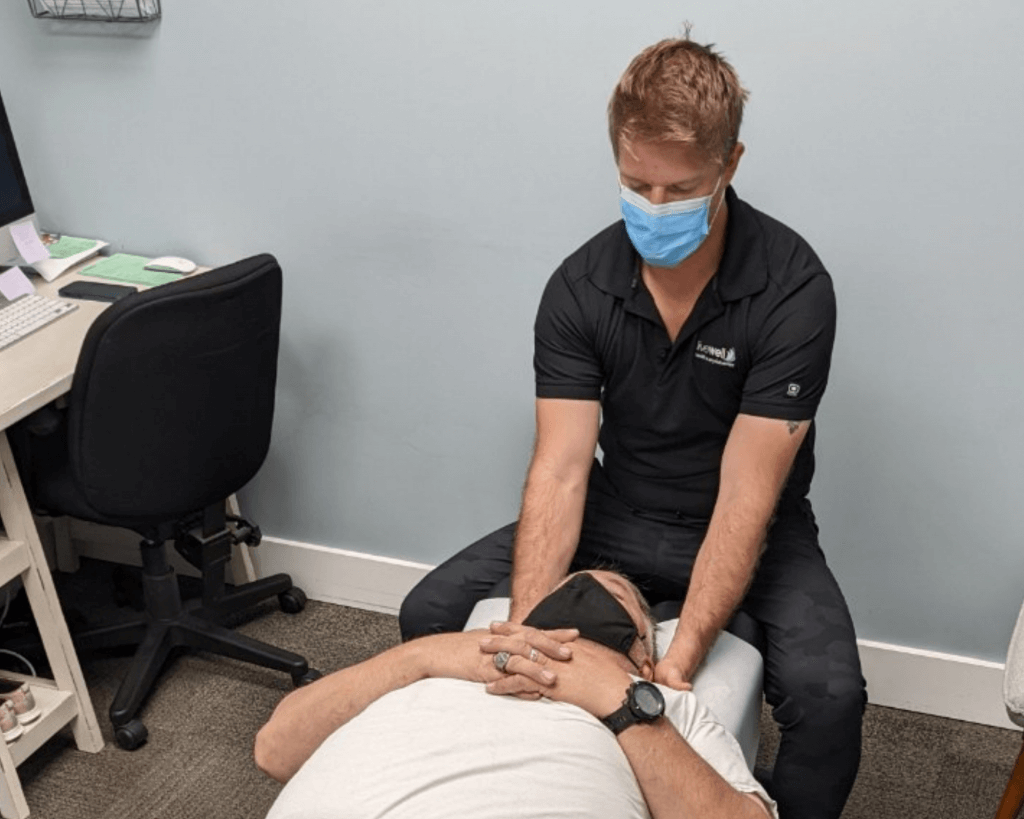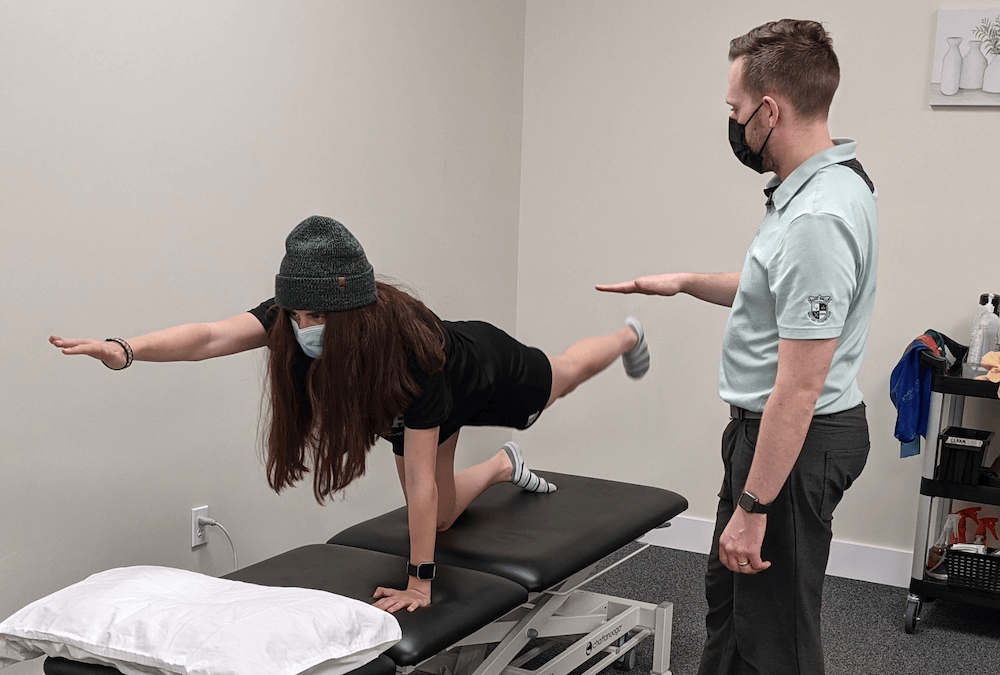Last month’s blog focused on our Physiotherapy, Chiropractic Care, and Massage Therapy services, which support our patients in treating their chronic conditions. This month, we’ll be diving into our Osteopathy, Acupuncture, and Pelvic Physiotherapy services, along with the ways in which our LiveWell team assists our patients in coping with chronic problems, dealing with injuries, and living a healthy lifestyle. Follow along this month’s blog to learn how LiveWell services can bring your health, wellness, and rehabilitation to where it needs to be!
1) Osteopathy
Osteopathy is a treatment based on the principle of treating the body as a whole. Whether it be a muscle, bone, joint, or nerve, it is designed to treat musculoskeletal pain by focusing on multiple areas of the body rather than a single point. Osteopathy strives to achieve optimal results and is also regarded as an ideal treatment for general body maintenance.
Our Osteopathy services are all about finding areas with tension, swelling, tenderness, or mobility issues while also manually restoring health. The service is based on our Osteopath’s in-depth understanding of the structure and function of the body, which is then applied to accessing diseases, disorders, and dysfunctions in order to find and address the root cause of the issue. This can include improving a patient’s body’s function, increasing mobility, and improving circulation. Treatment involves some soft tissue massage work, joint mobilizations to increase movement in stiff joints, and muscle energy techniques to stretch tight muscles. Other techniques such as active release, cranial-sacral therapy, and visceral manipulation can be added to the treatment when appropriate. All techniques are relaxing and comfortable, making the treatment an enjoyable one. Therefore, a typical Osteopathy treatment involves soft tissue massage work, joint mobilization to improve movement, and muscle energy techniques to stretch tight muscles.
Osteopathy is the ideal treatment for various conditions and pains, along with body maintenance as a whole. Whether you have a disease, disorder, or dysfunction, or are just experiencing pain in general, our team can detect and treat any bodily tensions. Using non-invasive manual therapy, our Osteopaths will unlock your body’s natural ability for self-correction and health restoration. This can involve following the tissue into specific positions while utilizing internal forces and rhythms through a series of purposeful movements. Some of the most common conditions our Osteopaths treat are listed below:
- Muscle or Tissue Tension
- General or Chronic Body Pain
- Headaches
- Disc Issues
- Tennis or Golfer’s Elbow
- Achilles Tendonitis
- Arthritis
- Sciatica
- Pinched Nerves
- Posture Issues
- Impact or Sports Injuries
- Frozen or Stiff Shoulder
- Repetitive Use Injuries
- Trauma from Whiplash or Falls
- Joint and Ligament Injuries
- Respiratory Issues
- Fertility and Pregnancy Issues
- Injury and Surgical Scar Tissue
- Stress-Related Issues
- Delayed Fine or Gross Motor Skills
- Attention-Deficit/Hyperactivity
- Poor Sleep Patterns
- Structural Assessment
- Digestive Difficulties

2) Acupuncture
Acupuncture in Western Medicine originates from Traditional Chinese Medicine and is a treatment used to alleviate pain and inflammation in the body. Acupuncture works by stimulating the body’s nerves through what are known as acupuncture points (meridians in tradition Chinese medicine). There are various acupuncture points throughout the body, each with a unique set of pain-alleviating outcomes. The technique focuses on treating a patient’s issues by using the insertion and manipulation of small needles in various parts of the body. As Acupuncture works throughout the body, a wide variety of pain and nervous system-related problems can be treated. Whether you’re experiencing pain or illness-related problems, there is a pathway that leads to the area which can be targeted through Acupuncture. Below are some of the common conditions that can be treated by Acupuncture:
- Migraines, Headaches, and Stress
- General Pain Including Injuries, Strains, and Sprains
- Immune System Issues and Illness Prevention
- Circulation and Recovery
- Chronic Pain, Sciatica Pain, Arthritis, Trigeminal Neuralgia, and Fibromyalgia
- Balance Problems Including Meniere’s Disease
- Sinusitis
- Menstrual Cramps
- Airway Problems Including Asthma
- Inflammation Including Tennis Elbow and Carpal Tunnel Syndrome
- Healthy Chemicals Including Endorphins, Norepinephrine, and Enkephalin
It’s important to note that Acupuncture treatments do not hurt. It is a very painless treatment that uses very thin and solid needles. Our Acupuncture providers insert needles into a patient’s acupuncture points with a quick “tap” motion, where the needles stay quite close to the skin’s surface in non-fleshy areas and a little deeper in fleshier areas. They will not harm any organs or blood vessels. Your Acupuncture providers will place as many needles as necessary that connect to the nerves in the area being treated. The amount of time the Acupuncture needles will be left in depends on what your Acupuncture providers thinks will be most effective as a means of pain treatment. Each needle is individually packaged and sterilized, and they are disposed of after use.
The method of Acupuncture described above is what is known as Manual Acupuncture, however, there are also Electromagnetic Acupuncture treatments. Electromagnetic Acupuncture uses a small electric charge from a machine to stimulate the nerves through the acupuncture needle. The sensation from this can feel like a small vibration through the area of treatment and is effective in treating pain as well. Your Acupuncture provider will provide you with the option between Manual Acupuncture and Electromagnetic Acupuncture and will establish a treatment plan that is best suited for your needs. If it is your first time receiving Acupuncture treatment, you may feel a little bit nervous, but in general, there is not much to worry about. In fact, many patients feel their pain is alleviated after just a few sessions!

3) Pelvic Physiotherapy
Your pelvic floor muscles are integral to your body’s overall health and assist with bladder, bowel, and sexual function. They are also essential to your core stability and help make sure your lower back can function properly and without pain. Just like most of the other muscle groups in your body, your pelvic floor muscles can sometimes be under too little or too much tension. With too little tension, you may experience stress incontinence and organ prolapse. On the other hand, when your pelvic floor muscles are under too much tension, you can experience pelvic pain or urgency and frequency of the bladder and bowels. It is also possible to have a combination of muscles in your pelvic area that are too tense while others are too relaxed. This is where Pelvic Physiotherapy comes to play. Our Pelvic Physiotherapists treat patients with all types of issues to help ensure a patient’s pelvic floor muscles are coordinating properly and provide proper function.
There are several symptoms that can arise due to pelvic floor dysfunction. Many of the symptoms are often brushed off as “normal”, however, they are not. It is not normal to leak when you cough/sneeze/exercise, to have pelvic pain or pressure, nor to have any pain with intercourse. Furthermore, and contrary to popular belief, most pelvic floor dysfunction patients cannot and should not treat their symptoms without professional help. In fact, sometimes trying to do so will do more harm than good. Below are some common symptoms of pelvic floor dysfunction:
- Urinary Incontinence (Stress or Loss of Control)
- Urinary Urgency and/or Frequency
- Prolapse of Pelvic Organs (Bladder, Rectum, or Uterus)
- Pain During or After Intercourse
- Painful Menstruation
- Bowel Dysfunction Including Constipation, Straining Pain, and Fecal/Flatus Incontinence
- Pain in the Lower Back, Tailbone, Genitals, or Rectum
- Pelvic Conditions Such as Endometriosis, Prostatitis, and Interstitial Cystitis
- Pregnancy and Post-Partum Issues Including Pain, Leakage, Pelvic Pressure, Diastasis Recti, or Scarring from Tearing, Episiotomy, or C-Sections
Our Pelvic Physiotherapists at LiveWell always take the time to customize your treatment plan based on your specific needs. We start with an initial assessment that will involve taking your medical history, diagnosing your issue, and explaining the best treatment options. Our Pelvic Physiotherapists assess and treat the pelvic floor through both external and internal exams. With pelvic health being crucial to the body’s overall wellbeing, we always encourage people to seek help as soon as they notice symptoms. Rest assured, no matter the condition, our Pelvic Physiotherapy services will provide treatment plans that will address any pelvic issues you may be facing.

—
As you can see, here at LiveWell, we offer a variety of health and physical therapy services that can treat any type of chronic condition you may be experiencing. Our Osteopaths, Acupuncture Providers, and Pelvic Physiotherapists have an abundance of knowledge and experience in helping patients cope with chronic conditions, heal from injuries, and live a healthy lifestyle. So, regardless of the condition, LiveWell can support you in all of your health and physical therapy needs! Head to our Service Pages to learn more about our services or contact us to book an appointment at our Lancaster, Waterloo, Driftwood, or Baden locations. Our team looks forward to supporting you in your health and rehabilitation!
Want more lifestyle advice on how to improve your health and wellness? Contact our LiveWell Health and Physiotherapy Kitchener (Lancaster and Driftwood), Baden, or Waterloo teams for more information and to book your next appointment. You can also reach out to us by email or social media, and one of our team members will be more than happy to answer any of your questions! All of our practitioners have tips and expert guidance to help improve your health and overall quality of your life.

